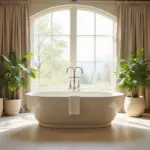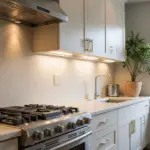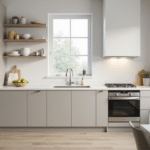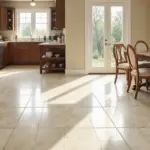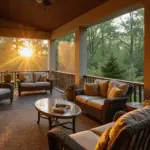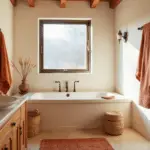The modern bathroom has transcended its utilitarian origins. No longer just a place for daily necessities, today’s bathroom serves as a personal retreat—a sanctuary where you can escape the desert heat and reconnect with yourself. In our climate-conscious world, bathrooms have become expressions of both personal style and environmental awareness.
The transformation of this space reflects our changing relationship with our homes. As we spend more time in our personal environments, we crave bathrooms that offer both functionality and tranquility—spaces that respond to our region’s unique climate challenges while providing moments of respite from the intensity of desert living.
The magic of modern bathroom inspiration lies in finding that perfect balance between form and function, between contemporary aesthetics and climate adaptation. Let’s explore how these 22 ideas can transform your bathroom into a desert-modern oasis.
1. Embrace Minimalism: Clean Lines and Clutter-Free Design for a Serene Bathroom
Minimalist bathroom design creates serenity through simplicity. The philosophy centers on stripping away excess and focusing on what truly matters: tranquility and functionality. In desert environments, this approach isn’t just aesthetically pleasing—it’s practical. Clean lines and uncluttered spaces create visual cooling effects that counterbalance our region’s intense heat, while neutral palettes of whites, grays, and sand tones reflect rather than absorb warmth.

The cornerstone of achieving this aesthetic is ruthless decluttering. Remove everything that doesn’t serve a clear purpose or bring genuine joy. Consider your daily routine and keep only essential items accessible. Invest in built-in storage solutions that keep necessities organized yet hidden from view. Floating vanities, wall-mounted fixtures, and recessed medicine cabinets maintain clean lines while providing necessary storage. Remember that minimalism requires consistent curation—a regular assessment of what deserves space in your sanctuary.
“The desert teaches us that less is more—in both design and resource use. A minimalist bathroom honors this wisdom through thoughtful restraint.”
The interplay between light and shadow plays a crucial role in desert-inspired minimalist bathrooms, creating depth without requiring additional elements. Unlike mass-produced alternatives, this technique allows the subtle play of natural light to become a design feature itself.
2. Spa-Inspired Sanctuary: Transform Your Bathroom into a Relaxing Retreat with Natural Elements
A spa-inspired bathroom serves as your personal oasis amid the arid landscape. It’s characterized by elements that evoke the tranquility found in nature’s most restorative environments. Natural materials take center stage, bringing the calming influence of the outdoors inside. In desert regions, this connection is particularly powerful—incorporating elements that reference the landscape creates a bathroom that feels intrinsically connected to its environment rather than fighting against it.

Even in smaller bathrooms, natural elements can transform the space. A small potted aloe or succulent brings life while requiring minimal water. Desert-sourced materials like sandstone or local clay tiles ground the space with regional authenticity. Sustainable bamboo accessories add warmth without excessive water requirements. Consider scents that evoke the desert after rain—subtle sage, piñon, or desert lavender fragrances can complete the sensory experience, engaging both body and mind in the relaxation process.
The craftsmanship in this collection tells a story of adaptation—how desert cultures have long created refreshing, cool spaces using natural materials and thoughtful design rather than resource-intensive technologies.
3. Natural Light Maximization: Design Your Bathroom to Bathe in Sunlight and Enhance Well-being
Natural light transforms a bathroom from merely functional to genuinely restorative. In our sun-rich desert environment, thoughtfully harnessed daylight becomes both a practical resource and a design element. Beyond aesthetic appeal, natural light stimulates serotonin production, enhancing mood and energy levels. It showcases the true colors of desert-inspired materials—the subtle variations in sandstone, the warm glow of copper fixtures, the rich texture of natural wood. Practically speaking, it aids ventilation and helps prevent moisture issues, particularly important in our region’s unique climate conditions.

Maximizing natural light requires strategic design considerations. Window placement should account for both the sun’s path and privacy needs. In desert regions, consider north-facing windows that provide consistent, diffused light without excessive heat gain. For windowless spaces, skylights or sun tunnels can transform dark bathrooms. Strategically positioned mirrors amplify available light, while light-colored surfaces in materials that reference the desert landscape—sand-toned tiles, limestone counters—reflect and distribute light effectively throughout the space.
The interplay between the colors creates a bathroom that evolves throughout the day as natural light shifts, mimicking the dramatic light changes that make our desert landscapes so captivating.
4. Statement Vanities: Make a Bold Impression with Unique and Functional Vanity Designs
A statement vanity transcends mere functionality to become the heart of your modern bathroom inspiration. Unlike standard utilitarian pieces, these vanities command attention through distinctive materials, unconventional forms, or innovative features. In desert-modern bathrooms, statement vanities often incorporate regionally-appropriate materials—mesquite wood with its remarkable stability in dry conditions, local stone with natural heat-resistant properties, or contemporary interpretations of traditional desert craftwork.

The true art lies in balancing visual impact with practical usability. Consider your specific storage needs and bathroom layout before committing to a design. The most successful statement vanities incorporate clever storage solutions that maintain clean lines while accommodating necessities. Look for vanities featuring water-efficient designs that complement desert living, such as integrated low-flow systems or gray water compatibility. Materials should withstand both moisture and our region’s dramatic temperature fluctuations—natural stone that stays cool to the touch or sustainably harvested woods that won’t warp in dry conditions.
- Choose vanities featuring local materials that tell a story of place
- Look for designs that incorporate water-saving features
- Consider heat-resistant surfaces that remain comfortable in all seasons
- Prioritize storage solutions that maintain visual simplicity
The unexpected environmental benefit comes from choosing locally-sourced materials, reducing transportation impacts while supporting regional craftspeople who understand our unique climate challenges.
5. Walk-In Showers: Indulge in Luxurious and Accessible Modern Shower Experiences
Walk-in showers have revolutionized modern bathroom inspiration, offering practical advantages perfectly suited to desert living. Their open design creates visual spaciousness—particularly valuable in our region’s often compact homes. The absence of barriers makes cleaning simpler, reducing water usage during maintenance. For those planning to age in place or accommodate family members with varying mobility needs, walk-in showers provide unmatched accessibility. Their inherent adaptability allows for integration of water-efficient fixtures and regionally-appropriate materials that perform beautifully in our dry climate.

Successful walk-in shower design requires thoughtful planning, particularly regarding water containment. The shower floor must have adequate slope—typically a quarter inch per foot—directing water efficiently toward the drain. In our water-conscious region, consider linear drains that maximize capture and minimize waste. Comprehensive waterproofing is essential, with special attention to transitions between materials. Glass panels or partial enclosures strategically placed can contain spray while maintaining the open aesthetic. For desert homes, consider heat-resistant flooring materials that remain comfortable underfoot despite temperature fluctuations.
While designed for the shower, we’ve seen creative uses of these principles in outdoor bathing spaces that connect to the landscape, blurring boundaries between indoor and outdoor living—a signature element of sophisticated desert architecture.
6. Freestanding Tubs as Art: Elevate Your Bathroom with Sculptural and Elegant Bathtubs
Freestanding tubs have transcended their utilitarian origins to become sculptural centerpieces in modern bathroom inspiration. Their appeal in desert-modern spaces comes from their ability to create a visual oasis—a place of refreshment and luxury amid our arid landscape. These statement pieces draw the eye, establishing a focal point that anchors the entire bathroom design. The versatility in placement allows for positioning that maximizes views of the landscape or creates intimate bathing experiences oriented toward indoor features like fireplaces—particularly welcome during our cool desert evenings.

Selecting the perfect freestanding tub involves considering both material and form. For desert environments, materials with excellent heat retention properties are ideal, allowing bathwater to maintain temperature longer without excessive energy use. Cast iron excels in this regard, while copper offers antimicrobial benefits and develops a living patina that evolves with use. Stone resin provides exceptional insulation with lighter weight. Shape significantly impacts both aesthetics and bathing experience—oval forms offer classic comfort, while rectangular designs provide contemporary minimalism. For truly desert-appropriate installations, consider tubs that conserve water through thoughtful internal shaping that requires less volume while maintaining comfort.
The artisans behind these designs began with a deep understanding of how bathing rituals can transform our relationship with water—particularly meaningful in water-conscious desert regions where each drop is precious.
7. Smart Toilets: Integrate Technology for Enhanced Hygiene and Comfort in Your Modern Bathroom
Smart toilets represent the intersection of technology and sustainability—particularly valuable in our water-conscious desert region. These sophisticated fixtures offer features that enhance both the user experience and environmental performance. Automatic flushing eliminates touch points, promoting hygiene. Heated seats provide welcome comfort during cool desert mornings. Built-in bidet functionality offers superior cleaning while dramatically reducing toilet paper consumption—an environmental win. Many models incorporate water-saving technologies that adjust flush volume based on actual need, conserving our region’s most precious resource while maintaining performance.

The investment in smart toilet technology delivers multiple returns. Beyond the immediate comfort benefits, improved hygiene reduces the spread of germs—particularly important in household bathrooms. Water conservation features can significantly reduce consumption, sometimes by thousands of gallons annually per household. The reduced need for toilet paper translates to both cost savings and environmental benefits. For those with mobility challenges, features like automatic opening/closing and hands-free operation enhance accessibility. Modern designs complement contemporary aesthetics while offering practical advantages that align perfectly with desert living principles of resource consciousness and technological adaptation.
For those worried about maintenance, the newest generation of smart toilets includes self-diagnostic features that identify potential issues before they become problems—particularly valuable in remote desert locations where service calls can be challenging.
8. Floating Vanities: Create a Sense of Spaciousness with Wall-Mounted Vanity Units
Floating vanities transform bathroom aesthetics while offering practical benefits ideally suited to desert living. By mounting to the wall and hovering above the floor, they create a compelling visual lightness that makes even modest bathrooms feel more spacious and airy. This design approach facilitates easier cleaning—particularly valuable in dusty desert environments where sand and soil regularly find their way indoors. The space beneath provides additional storage opportunities or simply remains open, enhancing the sense of expansiveness. Modern floating vanity designs often embrace clean lines and minimalist aesthetics that complement desert-modern style, with materials and finishes selected for their heat-resistance and durability in dry conditions.

When selecting a floating vanity, several considerations deserve attention. Wall strength is paramount—ensure the mounting surface can support the vanity’s weight plus contents. In desert homes with adobe or alternative construction, special mounting solutions may be necessary. Plumbing requires careful planning, as all connections must be concealed within the wall or vanity itself. Evaluate storage needs realistically; while floating designs may offer less conventional storage than floor-standing models, many incorporate ingenious organizational systems that maximize available space. Material selection should prioritize options that perform well in dramatic temperature fluctuations and low-humidity environments—natural stone that remains cool to touch or specially treated woods that resist cracking in dry conditions.
The unexpected environmental benefit comes from the reduced materials needed for floating designs, aligning with desert traditions of resource-conscious construction that dates back centuries in our region.
9. Geometric Tiles: Add a Touch of Modern Flair with Bold Patterns and Shapes on Walls and Floors
Geometric tiles inject personality and visual rhythm into modern bathroom inspiration, creating focal points that energize the space. In desert-modern design, these patterns often reference traditional motifs from indigenous cultures, reimagined through a contemporary lens. Beyond mere decoration, geometric patterns can subtly alter spatial perception—vertical arrangements can visually heighten ceilings, while horizontal patterns can visually expand narrow spaces. The inherent texture and visual complexity help camouflage water spots or dust—practical benefits in our region’s mineral-rich water and dusty conditions.

The world of geometric tiles offers endless possibilities for desert-inspired bathrooms. Consider hexagons that echo natural honeycomb formations found in desert bee colonies. Triangular patterns can reference the angular forms of desert mountains and rock formations. For a more subtle approach, consider tessellations in earth tones that create a seamless visual effect reminiscent of cracked desert soil patterns. Materials matter significantly—ceramic and porcelain offer durability and water resistance, while cement tiles provide thermal mass that helps moderate temperature fluctuations. For truly regional authenticity, explore tiles made from local clays or incorporating recycled materials from the area.
“The geometric patterns of desert landscapes—from crystalline salt flats to wind-rippled dunes—offer endless inspiration for bathroom tile designs that connect to place.”
What makes this design special is the way it references ancient desert architectural traditions while feeling thoroughly contemporary—a bridge between timeless regional wisdom and modern innovation.
10. Statement Mirrors: Reflect Light and Style with Oversized and Uniquely Shaped Mirrors
A statement mirror transcends functional reflection to become a central design element in desert-modern bathrooms. These distinctive pieces command attention through size, shape, or unique materials that complement regional aesthetics. Oversized mirrors dramatically enhance spatial perception, making modest bathrooms feel more expansive—a valuable quality in desert homes where space efficiency matters. Beyond size, unconventional shapes add artistic dimension; consider organic forms that reference desert landscapes or geometric patterns inspired by indigenous designs. Frames crafted from regional materials—mesquite wood, copper with desert patina, or stone with visible mineral striations—add authentic character while supporting local artisans.

The benefits of oversized mirrors in desert bathrooms extend beyond aesthetics. They maximize both natural and artificial light, reflecting and distributing illumination throughout the space—particularly valuable during intense summer months when minimizing heat-generating artificial lighting becomes important. This light amplification creates a more energizing morning environment while reducing electricity demands. The expanded reflection space accommodates multiple users simultaneously, enhancing functionality for households sharing bathrooms. When positioned strategically to capture views of architectural features or glimpses of the landscape, statement mirrors can visually double the impact of thoughtful design elements.
The magic of this piece lies in its ability to capture the changing desert light throughout the day, reflecting the subtle shifts that make our regional light so distinctive and celebrated by artists worldwide.
11. Understated Elegance: Explore Neutral Color Palettes for a Timelessly Modern Bathroom Aesthetic
Neutral color palettes form the foundation of timeless desert-modern bathrooms, offering both practical and aesthetic advantages. These understated schemes create a sense of calm that complements our region’s intense landscape, providing visual relief from the dramatic colors outside. Their enduring appeal transcends trends, ensuring your bathroom remains relevant for years—a sustainable approach that reduces the need for frequent renovations and their associated resource consumption. Neutral backgrounds adapt easily to seasonal changes; simple accessory swaps can transition the space from summer’s cooling blues to winter’s warming terracottas without major investments.

Desert-inspired neutral palettes extend beyond basic beige and white. Consider warm grays that reference morning fog in desert valleys, paired with creamy whites that echo the region’s limestone formations. Sand and stone combinations bring textural interest while maintaining a cohesive, grounded feel. For more depth, explore greige (gray-beige) and taupe, colors that bridge warm and cool tones while evoking the complex hues of desert soil. Earthy neutrals incorporating subtle undertones of terra cotta, sage, or clay connect directly to our landscape while maintaining the restrained elegance that characterizes sophisticated desert design.
Running your hand across these natural materials reveals subtle variations in texture and temperature—cool stone that provides relief on hot days, warming wood that feels inviting during desert evenings—creating a multi-sensory experience rooted in place.
12. Bold Accents: Inject Personality with Pops of Color through Accessories and Fixtures
While desert-modern bathrooms often embrace neutral foundations, bold accents prevent them from feeling sterile or impersonal. These strategic color moments inject vitality and character, transforming functional spaces into expressions of individual style. In our region, accent colors often draw from the landscape—the fiery orange of desert blooms, the deep turquoise of rare water sources, or the rich copper of mineral-laden soil. These connections to place create bathrooms that feel authentically rooted rather than arbitrarily designed.

Introducing bold color accents requires thoughtful restraint. Textiles offer versatile and easily changeable options—towels in sunset hues or bath mats referencing the pattern and color of local vegetation. For more permanent statements, consider colored fixtures; a copper sink develops a living patina that evolves with use, while matte black faucets create dramatic contrast against lighter surfaces. Artwork featuring regional landscapes or botanical illustrations of desert plants adds color while strengthening the connection to place. Colored glass accessories—soap dispensers, vessels, or decorative objects—catch and transform light throughout the day, mimicking the way desert light changes from dawn to dusk.
- Incorporate textiles in colors drawn from the regional landscape
- Consider metal fixtures that develop natural patinas over time
- Add colored glass elements that interact with changing desert light
- Include artwork depicting local flora, fauna, or landscapes
The challenge of awkward spaces becomes easier when bold accents draw attention to intentional focal points, directing the eye exactly where you want it to go—a design strategy borrowed from how we experience the vast desert itself.
13. Natural Materials: Incorporate Wood, Stone, and Concrete for an Organic Modern Feel
Natural materials form the cornerstone of authentic desert-modern bathroom inspiration. Their integration creates spaces that feel connected to the landscape rather than imposed upon it. These materials bring warmth and tactile interest to environments often dominated by hard, manufactured surfaces. The subtle variations and imperfections found in natural materials—the grain pattern in drought-resistant woods, the mineral striations in local stone—add character that mass-produced alternatives cannot replicate. This connection to natural elements promotes relaxation and wellbeing, creating bathrooms that serve as restorative retreats.

When incorporating wood in desert bathrooms, moisture resistance must be balanced with sustainability. Consider species adapted to arid conditions, such as mesquite or acacia, which naturally withstand dramatic humidity fluctuations. For stone elements, look to materials found in our regional geology—travertine, sandstone, or limestone—which perform beautifully in desert conditions while minimizing transportation impacts. Concrete offers versatility and thermal mass, helping moderate temperature swings while providing opportunities for custom colors and textures that reference the landscape. Whatever materials you select, proper sealing and maintenance are essential to ensure longevity in bathroom conditions.
The sustainable journey of these materials involves careful harvesting practices that respect desert ecosystems, supporting regional economies while creating bathrooms with authentic sense of place—a thoughtful alternative to imported materials with heavy carbon footprints.
14. Brass and Gold Fixtures: Infuse Warmth and Glamour with Metallic Accents
Brass and gold fixtures have experienced a renaissance in modern bathroom inspiration, particularly well-suited to desert-modern aesthetics. These warm-toned metals reference the region’s mineral wealth and complement the golden quality of desert light. Unlike cooler finishes like chrome or stainless steel, brass and gold provide a rich visual warmth that softens contemporary bathrooms, creating inviting environments that glow rather than glare. Their ability to develop natural patinas over time adds living character that evolves with use—particularly appropriate in a region where natural aging processes are celebrated rather than hidden.
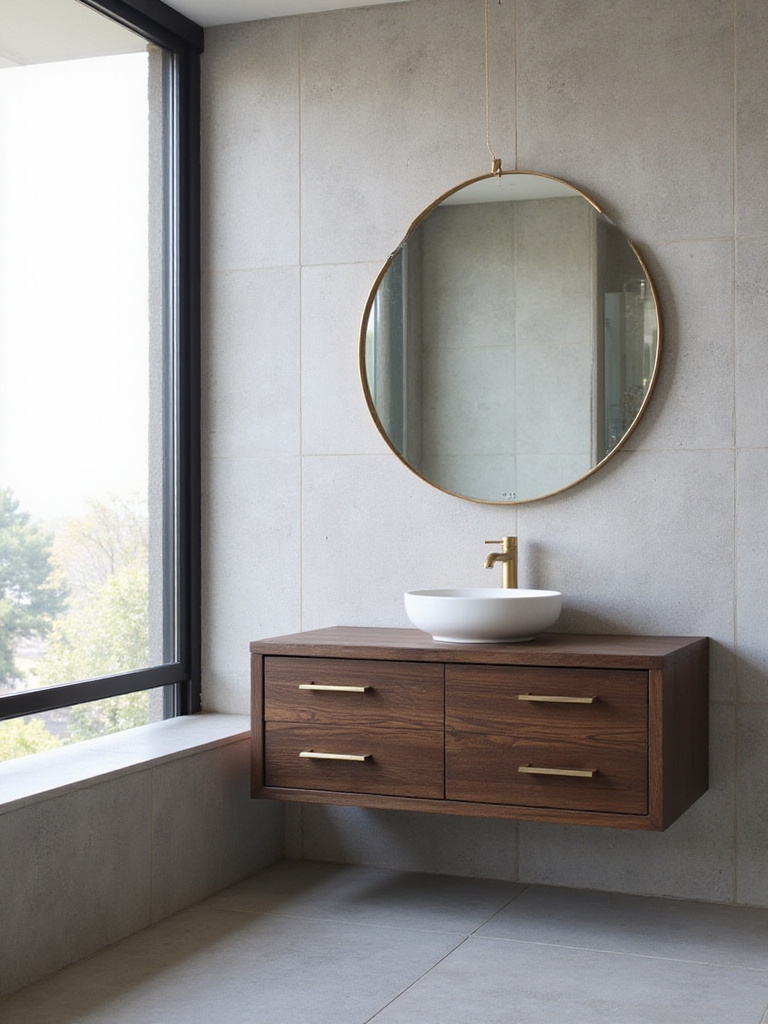
Selecting between brass and gold requires consideration of both aesthetic and practical factors. Brushed brass offers a more subdued contemporary look that shows fewer water spots—practical in areas with mineral-rich water. Polished gold creates dramatic reflective surfaces that amplify light, but requires more frequent cleaning to maintain its lustrous appearance. Consider how the metal will interact with other elements in your bathroom; brass harmonizes beautifully with earthy tones and natural materials, while gold can elevate cooler palettes with a touch of warmth. For truly regional authenticity, explore fixtures made with reclaimed metals or produced by local artisans who understand the unique qualities of desert light and how metals respond to our climate conditions.
The silhouette draws inspiration from traditional water vessels used throughout desert cultures, reimagined through a contemporary lens that honors historical water wisdom while embracing modern efficiency.
15. Matte Black Finishes: Embrace Sleek and Contemporary Hardware for a Modern Edge
Matte black finishes have emerged as a defining element in desert-modern bathroom inspiration. Their sophisticated presence creates dramatic contrast against lighter elements typical in desert palettes—the stark juxtaposition referencing the dramatic light conditions of our landscape. The non-reflective quality of matte black absorbs rather than reflects light, creating visual anchors within the design. This absence of shine offers practical advantages in our mineral-rich water conditions; matte finishes show fewer water spots and fingerprints than their polished counterparts, maintaining a clean appearance with less maintenance.

The versatility of matte black extends across virtually every bathroom hardware category, allowing for complete design cohesion. Faucets, showerheads, towel bars, cabinet hardware, and even drain covers are readily available in this finish. When selecting matte black elements, prioritize quality construction—look for solid brass or stainless steel cores with durable coatings designed to withstand bathroom conditions. The contrast between matte black hardware and natural materials creates compelling visual tension; consider black fixtures against light limestone, warm wood, or textured concrete for maximum impact. For a cohesive yet nuanced approach, incorporate varying black tones and textures—combining matte black metal with black stone or textured black tile creates depth while maintaining the monochromatic discipline.
The designer’s attention to detail shows in how these matte elements absorb and define light rather than reflecting it—mimicking the way desert shadows create definition and dimension in the landscape.
16. Indoor Greenery: Breathe Life into Your Bathroom with Plants and Vertical Gardens
Incorporating plants into desert-modern bathrooms creates a vital connection to living systems, bringing numerous benefits beyond mere decoration. Plants improve air quality by absorbing toxins and releasing oxygen, creating a healthier bathing environment. Their presence has measurable calming effects, reducing stress and promoting wellbeing—particularly valuable in spaces dedicated to self-care. In our arid region, bathroom humidity creates microenvironments where certain plants thrive with minimal intervention, making them surprisingly low-maintenance additions. The strategic introduction of greenery softens hard architectural lines while adding color and texture that evolves seasonally.

Selecting appropriate plants for desert bathroom environments requires understanding both humidity patterns and light conditions. Snake plants (Sansevieria) thrive in low light and require minimal water, making them ideal for bathrooms with limited windows. Aloe vera not only tolerates bathroom conditions but offers practical benefits—its gel can soothe sun-exposed skin, a frequent need in desert living. Air plants (Tillandsia) absorb moisture directly from humid air, eliminating the need for soil and creating striking sculptural displays when mounted on walls or suspended in glass containers. For bathrooms with adequate light, consider small specimens of desert-adapted plants like Haworthia or Echeveria, which connect directly to the regional landscape while thriving in the bathroom’s unique conditions.
Even in smaller spaces, here’s how this works: mount a simple wooden shelf near a light source and arrange a collection of small drought-tolerant plants that benefit from shower humidity while requiring minimal care—bringing life to your bathroom without demanding much of yours.
17. Ambient Lighting: Layer Lighting for a Relaxing and Mood-Setting Bathroom Environment
Ambient lighting transforms bathroom functionality into experience, playing a crucial role in desert-modern design. Unlike task lighting’s focused illumination, ambient lighting creates atmosphere and mood—essential elements in bathrooms designed as retreats from our region’s intense environment. Thoughtfully layered ambient light avoids harsh shadows and stark contrasts, creating softer, more inviting environments that promote relaxation. In desert regions where daytime light can be blindingly bright, the ability to create gentler evening bathroom environments becomes particularly valuable.

Creating effective ambient lighting involves strategically layering different light sources. Recessed ceiling fixtures provide foundation illumination, ideally connected to dimmer switches that allow adjustment throughout the day. Wall sconces at eye level cast soft light that flatters skin tones while reducing shadows—particularly important in bathrooms used for grooming. LED strip lighting installed under floating vanities, behind mirrors, or along ceiling coves creates subtle indirect illumination that mimics the way light reflects off desert landscapes at dawn and dusk. Consider fixtures made from regional materials—perforated metal that creates patterned light reminiscent of dappled shade, or handblown glass incorporating desert minerals that transform light quality.
The emotional response this evokes begins with a sense of decompression—the bathroom becomes a transition zone between the intensity of desert light and the restfulness of evening, supporting natural circadian rhythms disrupted by modern living.
18. Open Shelving: Combine Style and Functionality with Decorative and Accessible Storage
Open shelving has revolutionized storage in modern bathroom inspiration, offering a compelling blend of accessibility and display opportunity. In desert-modern bathrooms, open shelving references traditional adobe niches while providing contemporary functionality. The primary advantage is immediate access to frequently used items—towels, toiletries, and decorative objects—eliminating the need to open cabinets or drawers. Visually, open shelving creates a more expansive feeling, particularly valuable in modest bathrooms where every square inch matters. The visibility encourages thoughtful curation and organization, transforming storage from purely functional to aesthetically intentional.

Selecting appropriate materials for bathroom open shelving requires understanding the unique conditions of desert environments. Solid wood, when properly sealed with water-resistant finishes, brings natural warmth while withstanding humidity fluctuations. Consider regionally appropriate species like mesquite or ironwood, known for their stability in changing conditions. Metal shelving, particularly in powder-coated finishes, offers durability and contemporary lines that complement modern aesthetics. Glass provides a virtually weightless appearance that enhances spaciousness while being impervious to moisture. For truly authentic desert-modern installations, explore shelving made from compressed earth materials or concrete with local aggregate, connecting storage elements directly to regional building traditions while offering exceptional durability.
The quality becomes evident after years of use when these thoughtfully selected materials develop character rather than deterioration—a testament to the value of choosing materials appropriate to place rather than following generic trends.
19. Seamless Transitions: Extend Your Home’s Design Flow into the Bathroom for Cohesion
Creating seamless transitions between bathrooms and adjacent spaces is a hallmark of sophisticated desert-modern design. This continuity prevents bathrooms from feeling like afterthoughts, instead integrating them into the home’s overall design narrative. When bathrooms share material palettes, color schemes, and architectural details with surrounding spaces, the entire home feels more intentionally designed and harmonious. This approach reflects desert building traditions where resource limitations necessitated cohesive use of local materials throughout structures.

Achieving seamless transitions requires coordinating key design elements across spaces. Consider flooring continuity; using the same material or complementary options creates visual flow between rooms. Architectural details like door styles, trim profiles, and hardware finishes should maintain consistency. Color palettes should evolve naturally rather than change abruptly at bathroom thresholds. Even subtle elements like lighting temperature and fixture styles contribute to the sense of continuity. In desert homes where indoor-outdoor living is emphasized, bathroom design might reference exterior materials and colors, creating connections not just to adjacent interior spaces but to the landscape beyond.
If you’ve struggled with similar rooms before, the key difference is thinking of your bathroom not as a separate utilitarian space but as an integral part of your home’s design story—a continuation of the narrative rather than an interruption.
20. Textural Walls: Add Depth and Interest with Unique Wall Finishes like Textured Tiles or Paneling
Textural walls elevate desert-modern bathroom inspiration beyond the purely visual, creating multi-sensory environments that engage touch as well as sight. These dimensional surfaces add depth and complexity without requiring bold colors or patterns, perfect for creating interest while maintaining the restrained palette typical of sophisticated desert design. Textured walls interact dramatically with our region’s distinctive light qualities—creating shifting patterns of shadow and highlight throughout the day that reference the way sunlight plays across desert landscapes. This dynamic quality brings subtle animation to bathroom environments, making even small spaces feel more engaging and alive.

The range of materials available for creating textured bathroom walls offers numerous possibilities for desert-inspired design. Three-dimensional tiles in patterns that reference regional landforms—rippled like wind-shaped dunes or angular like eroded canyons—create dramatic focal points. Tadelakt, a traditional Moroccan lime plaster technique with desert origins, creates waterproof surfaces with subtle movement and depth. Textured concrete incorporating local aggregate connects directly to the landscape while providing excellent durability in bathroom conditions. Wood slat walls, particularly using regionally appropriate species, add warmth and rhythm while creating interesting shadow patterns. For more subtle texture, consider microcement finishes in earth tones that reference the region’s soil and rock formations, providing tactile interest while maintaining clean lines.
The revival of this classic form comes with a twist—these ancient techniques for creating textural interest have been reimagined for contemporary spaces, honoring traditional desert building wisdom while meeting modern performance expectations.
21. Japandi Bathrooms: Blend Japanese Minimalism and Scandinavian Warmth for Serene Spaces
Japandi bathroom design offers a particularly relevant approach for desert living, combining Japanese minimalism with Scandinavian warmth to create spaces that feel both serene and inviting. This fusion philosophy embraces restraint without austerity, finding beauty in simplicity while maintaining comfort. The Japanese concept of ‘wabi-sabi’—finding beauty in imperfection and natural processes—resonates deeply with desert aesthetics, where weathering and patina are celebrated rather than disguised. Scandinavian influences contribute warmth and livability, ensuring spaces feel welcoming rather than severe. Together, these influences create bathrooms that feel intentionally designed yet effortlessly comfortable.

Authentic Japandi bathrooms in desert settings incorporate elements from both traditions while responding to regional conditions. Natural materials take center stage—wood, stone, and plant fibers—but with careful selection for drought-adaptation and heat-resistance. The color palette typically features neutrals with subtle undertones drawn from the landscape: sand, clay, and stone. Functionality and decluttering are paramount, with every element serving a clear purpose. Ritual aspects of bathing are honored through thoughtful details like wooden stools, natural sponges, or specially designated spaces for pre-bath cleansing—practices that align with water-conscious desert living principles by separating cleansing from soaking, reducing overall water usage.
The unexpected material discovery story behind many Japandi bathrooms involves finding surprising connections between desert traditions and Japanese aesthetics—both cultures have developed sophisticated approaches to creating comfort in challenging environments through material wisdom rather than resource-intensive technologies.
22. Tech-Integrated Bathrooms: Discover Smart Showers, Mirrors, and Features for Modern Living
Technology integration in desert-modern bathrooms goes beyond novelty to address specific regional challenges, enhancing comfort while promoting resource efficiency. Smart showers exemplify this dual benefit: programmable settings allow personalized experiences while precision controls reduce water waste—crucial in our water-conscious region. Voice-activated features eliminate touch points on surfaces, improving hygiene while adding convenience. Leak detection systems provide early warning of potential water issues, particularly valuable in areas where water damage can be especially costly and conservation is imperative. These technologies transform bathrooms into spaces that respond intelligently to both user preferences and environmental constraints.
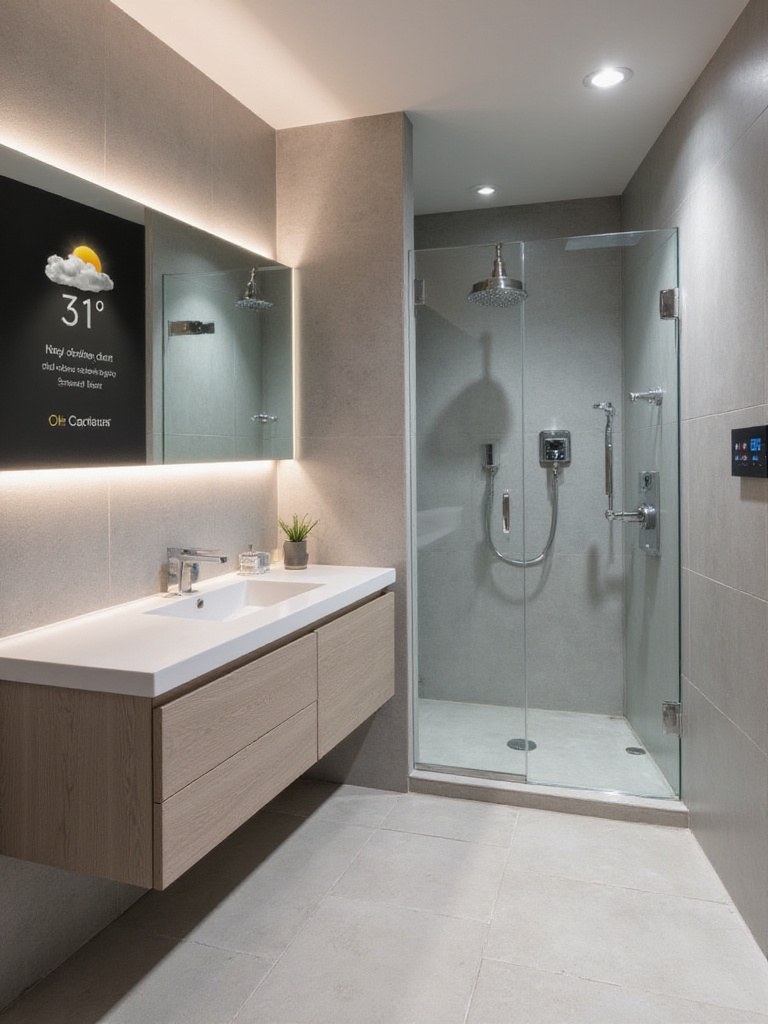
The range of available bathroom technologies continues to expand, with options at various price points. Smart showers ($500-$5000+) offer programmable settings, water usage tracking, and even water recycling systems that align with desert conservation priorities. Smart mirrors ($200-$2000+) provide information and entertainment while serving as lighting sources, potentially reducing overall energy consumption. Smart toilets ($500-$10,000+) with features like precise water usage and leak detection directly address water conservation concerns. Climate control systems can be particularly valuable in desert regions with extreme temperature fluctuations, maintaining comfortable bathroom environments while minimizing energy use through precise management rather than overcompensation.
When clients ask us about balancing style with technology, we emphasize selecting systems that solve genuine regional challenges rather than adding complexity for its own sake—technology should enhance the desert living experience by making resource conservation effortless and comfort accessible.
Conclusion: Creating Your Desert-Modern Bathroom Sanctuary
Throughout this exploration of modern bathroom inspiration, we’ve discovered how thoughtful design can transform utilitarian spaces into personal sanctuaries that respond intelligently to our unique desert environment. From the serene simplicity of minimalist designs to the cutting-edge convenience of integrated technology, each approach offers distinctive benefits while honoring our region’s particular needs and aesthetic traditions.
The most successful desert-modern bathrooms share key characteristics: they embrace rather than fight our climate, they incorporate materials with authentic connections to place, and they balance beauty with resource consciousness. Whether you’re drawn to the organic warmth of natural materials, the sleek sophistication of contemporary fixtures, or the tranquil fusion of Japandi aesthetics, your bathroom can become a space that refreshes both body and spirit while respecting our precious desert resources.
As you reimagine your own bathroom, remember that the most compelling spaces tell a story of place—they reference our landscape, honor regional building wisdom, and create experiences that respond to the distinctive qualities of desert living. Your modern bathroom inspiration doesn’t need to come from distant design traditions; sometimes the most innovative solutions are found by looking more deeply at what’s already around us, reinterpreted through a contemporary lens. The result is a bathroom that feels both timeless and thoroughly modern—a true desert sanctuary.

